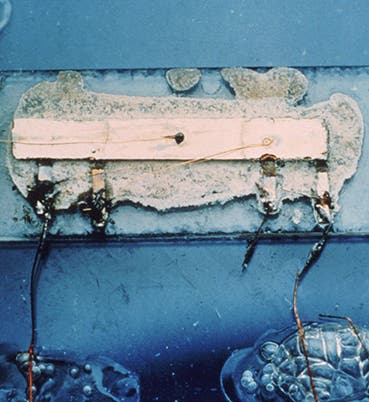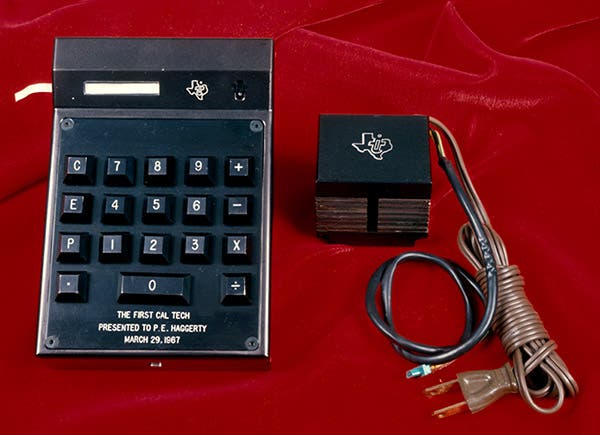Scientist of the Day - Jack Kilby
Jack Kilby, an American electrical engineer, was born Nov. 8, 1923. In 1958, Kilby was working at Texas Instruments, a recently established Dallas company that had produced the first commercial silicon transistor in 1954 (and the first transistor radio). A typical electronic circuit involved transistors, resistors, and capacitors, each of which were separately manufactured and wired together. Since it was theoretically possible to make resistors and capacitors out of semiconductor material (silicon or germanium), Kilby wondered whether it was possible to make an "integrated" circuit, with all the components manufactured at once on a single semiconductor wafer. He got the idea in July of 1958 (making his first sketch in his lab notebook, second image) and received permission to pursue the idea. By September, Kilby had a working oscillator built of a single germanium wafer that he was able to demonstrate to the lab director (first image). A month later, he built an integrated "flip-flop" circuit, a basic storage device, this one entirely from scratch. A patent was applied for early in 1959 (although not granted until 1964), and the integrated circuit was announced in March of that year. As it happened, an engineer at Fairchild Semiconductor, Robert Noyce, independently built his own integrated circuit, later than Kilby, but with some important improvements, including getting rid of the “flying wires” visible in the first image. Today, both men are acknowledged as independent inventors of the integrated circuit.
Klrby recalls being surprised at the criticism and opposition that the early integrated circuits aroused. There were only a half-dozen people who saw potential in the concept (one of these was Gordon Moore, who in 1965 would predict the future of integrated-circuit growth with "Moore's Law"). Many critics thought that integrated circuits could not be produced in bulk, would be too expensive, and would not work as well as separate components. Plus, electrical engineers feared that the integrated circuit would put them out of work. The turnaround came when the Apollo program and the Minuteman missile program both switched over to integrated circuits, suggesting to manufacturers that integrated circuits might be very reliable indeed.
Kilby helped demonstrate the utility of his invention when he, now as lab director at TI, headed up a team to make the first hand-held calculator, utilizing integrated circuits. The Caltech, as it was called, premiered in 1967, and one of the early models is in the American Museum of American History at the Smithsonian. At 38 ounces (almost 2 1/2 pounds), it was not exactly a pocket calculator, but it was a very effective harbinger of the coming revolution in electronics that the integrated circuit would make possible.
Kilby shared the Nobel Prize in Physics in 2000 for his invention. Noyce had died in 1990, making it impossible for him to share in the award.
Dr. William B. Ashworth, Jr., Consultant for the History of Science, Linda Hall Library and Associate Professor, Department of History, University of Missouri-Kansas City. Comments or corrections are welcome; please direct to ashworthw@umkc.edu.








